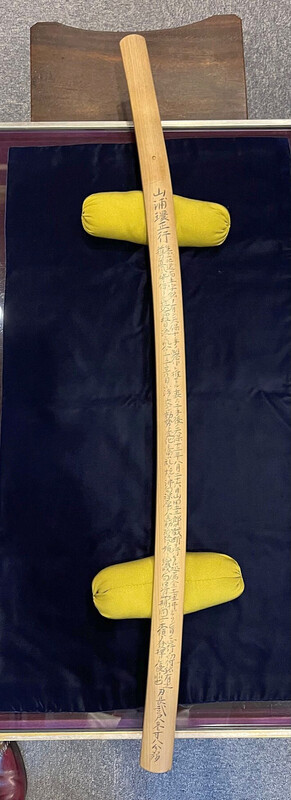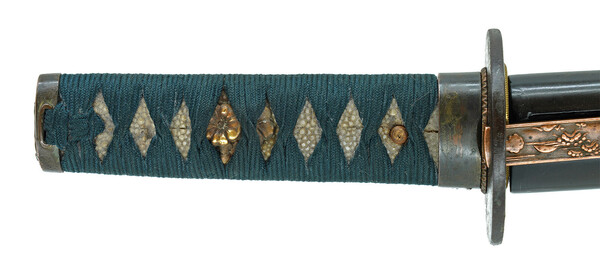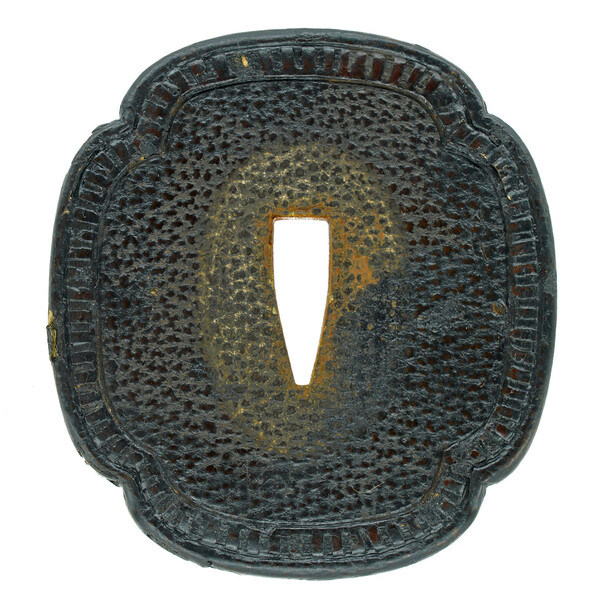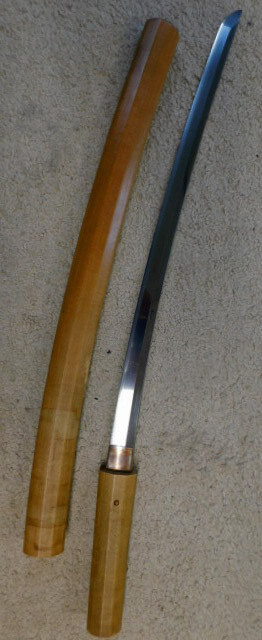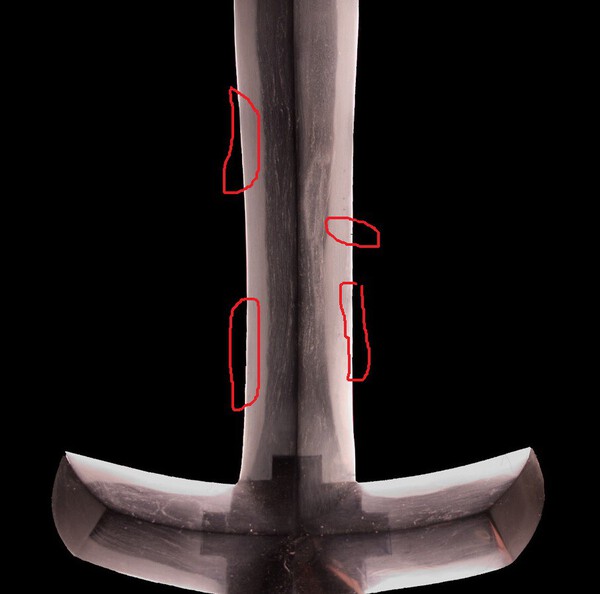-
Posts
161 -
Joined
-
Days Won
8
Everything posted by Promo
-
Thank you! As you might know better than I do there is a lot of meaning to the particular Kanji being used - and Markus was kind enough to let me know in very deep detail on my sayagaki. He told me that mine is classified as "yūhin" (優品), what represents the highest level that Tanobe is using. According to him there is also "kasaku" (佳作) or "ryōsaku" (良作), which as well can be translated as "masterwork" or "excellent work". He though also mentioned that a very rare exempt (and superior to yūhin) would be "saikō-kessaku" (最高傑作), what can be translated as "biggest masterpiece of this smith" - but he also mentioned that Tanobe stopped using this term a few years ago.
-
Markus helped me with a proper English translation of the sayagaki. It reads as:
- 274 replies
-
- 10
-

-

-
That, to my surprise went very fast this time. The Sayagaki by Tanobe is already done - and I even have a nearly full (since opposite side missing) translation by @Markus for it. The Japanese reads as: Or I did get a German translation to this as well, but maybe @Markus can help for others in here with an English translation since I doubt I am able to translate a Japanese to German translation to English without making any errors.
-
Please forgive for not updating a longer time. It missed being submitted to Juyo, so the first try then will be this year - another year in Japan! The time will be used nevertheless with sayagaki. I though got some additional pictures that show more of its beauty and make me look highly forward to it. Find them attached.
- 274 replies
-
- 19
-

-

-

-
That one is interesting in that the Tsuba is also fully leather covered whereas the one from @PNSSHOGUNs link isn't. Plus it also comes with TH papers for the Koshirae (... and the blade is a Juyo blade, wow). I really wonder how the blade would look like back in polish.
-
Having personal experience with costs for Polish, Habaki and Shirasaya I do know approx. costs, and I'm afraid these are around € 2000 for a Katana (/Tachi, since it seems it may be called either), if done in Japan. And while in Japan one would also get it papered, so another € 500 atop. So the costs for the restoration and papering of the blade only will already be at € 2500 - and I don't know if Koshirae should be sent along too for restoration, since it should afterwards still fit the blade, plus the wrapping has some minor damage so that it maybe should be restored as well. I can deduct this from the value of a fully restored blade, but I honestly do not know how much it would be worth.
-
@ROKUJURO thanks for the clarification - that is what I know and had understood, but the previous post by @PNSSHOGUN confused me for him calling it a Tachi. Thank you for naming a number btw, does this one refer to both or only the Katana? Adding in the costs of a polish and considering the cleaned nakago it is way more than I thought and makes me wonder if the polished blade afterwards would indeed have this value. @Alex A thanks for the compliment. Having had to professionally picture firearms for literature provided me with enough experience to do advanced pictures. But the highly glossy and silver finish of blades is a tough new challenge, I'm not very pleased so far with my results.
-
@PNSSHOGUN is it now a Tachi or a Katana in Tachi mountings? I had considered this too, but I still would need to know what either of them is worth.
-
-
So the first blade isn‘t a Wakizashi but a short Katana in Tachi mounts.. seems I got it as much wrong as possible! Thanks for clearing this. And special shout-out to @Ray Singer and his incredible deciphering skills! If I found the correct one it appears there were two (father and son) using this name, is the first generation the correct one that I had identified? Prior going to bed I wiped down the koshirae of both with oil soaked clothing. Now they look much better, first one now is black with a light brown touch. Just did the better pictures of the blade, this time with the camera and not with the mobile. They do it more justice. Notice I slided the front swivel ring on the scabbard a bit back in the second picture, to show it isn't sitting on the retaining ring as it should be. I hope this allows to give a better judgement of the blade.
-
To help keep separated another post for the second blade, also a Wakizashi. It is remarkable shorter than the first one at 49,6 cm total length and 37,4 cm cutting length. It is not signed. The Koshirae is pretty simple (though I really LOVE that duotone Habaki! Very cool combination which I had not seen before). Please forgive me the cat hair on the kissaki area, noticed it after the pics were taken. Same question on this one, but since unsigned of course I would appreciate any guesses on period and maker as well as on potential value and simply anything else you could tell me on it. Thanks!
-
Unfortunately prior to Christmas a very dear friend of mine passed away. He was a (retired) gunsmith, the most honest person I had ever encountered in this business. I'm deeply missing him. For what he meant to me I told his son if I can be of any assistance he should ask me. While the family now cleared his workplace where he still drove nearly every day for a few hours just to be kept busy they called me and asked me if I can take a look at various items. Among the items that turned up were two Japanese Wakizashi, both in Koshirae. They are looking to sell these items and I know they surely will not be worth a lot, but I would appreciate any input on them. The first blade is the "longer" wakizashi with an overall blade length of 78,8 cm, cutting length 63,4 cm. It becomes noticeable thinner towards the kissaki (many previous polishes?). The Koshirae is quite unusual in it seems that nearly everything is wrapped in something that almost looks like snake or crocodile skin, including the Tsuba. Menuki appears to be an octopus? There is a signature on the nakago which unfortunately quite obviously has been rather crudely got cleaned. The signature is not very strong, so having a tough time with it. I would appreciate input on this blade, especially on what the signature reads (plus any potential information on the maker), to approx. when this blade dates and (more for personal interest) what the Koshirae is wrapped in, since I cannot recall seeing one like this before. Finally, any input on its value would also be appreciated.
-
Thanks for confirming my suspicion @Ray Singer! If not too much, would you mind elaborating what the documents are that come with the blade?
-
I'd kindly request opinions on the attached shown Wakizashi that to my best knowledge is signed "hizen no kuni mutsu no kami tadayoshi", but I do not feel able to tell whether gimei (my personal guess) or if original. Since it is accompanied by various papers as well of which I honestly have no idea what they are I'd also appreciate any input on what those are and maybe even what they are saying. Thanks in advance!
-
Considering what someone not into nihonto might understand by this sentence kept me laughing way more than it should! Looking forward to what your oil based cleaning can come up with. Keep us posted!
-
Hammer price was $ 85,000. The price listed above includes BP.
-
Robert, for a small fee Markus Sesko offers a full translation service for NBHTK certificates which comes to you as a PDF file that you can print and keep along with the certificate. This way you will not have to search for this thread in years and puzzle back the individual portions. Especially since we are talking on a Juyo blade I think it should be worth it. I'm sure he'd do the sayagaki as well.
-
It seems to me that the white balance is incorrect since your picture has lots of red in it. Make sure to have the correct setting and then re-take them; when reworking avoid using settings such as "auto tone" or "auto color". Additionally the outer border where the "black part" begins is extremely sharp, especially when looking at it in full resolution. The therefore extreme contrast from a white pixel whereas the next is dark and not even where it "jumps back a pixel in the row below" (tough to express things like that when not a native English speaker, I hope you nevertheless understand what I mean!) there is a single pixel that tries to smoothen this contrast, it simply looks like done in minecraft when looking at it in detail. I highlighted some of the later mentioned details in the attached picture, maybe this makes it easier to understand. You might also try experimenting with HDR pictures, especially since it anyway is a still picture.
-
Not my fingerprints since I did not touch any of the bare metal - didn't see them in person, otherwise would had wiped it though. Thanks for the translation of the tsuba signature! So this one is muromachi period?
-
Has anyone ever seen such a "dark line" within the blade before? Any possible explanation for this? Thanks for the translation @Toryu2020 - is this the full signature or do you think a part has been cut off? And which period does it date to?
-
@Geraint, once more thanks for the help! I missed to measure all blades individually, might be doing this next time. I was limited in time and during taking the blades apart and doing pictures the phone rang like every 5 minutes as well. Had not even had enough time to enjoy the blades myself! Noticed right now that I seemed to have missed to take an overall picture of this blade at all - damn, I should had done better.
-
@Grey Doffin, thanks for the translation! Would you mind telling me which Masatoshi this is? I got several results for smiths with this name, hence my question. @Geraint, the koshirae is very cool to look at, especially since additionally painted on. Re the length, for what I remember this one was slightly above 30cm, so very short.
-
Thanks for the feedback! Does anyone have an idea on the smith/can help with translation? @Bruce Pennington, I can at least tell from handling it that it really looked great for a WWII blade!
-
-



